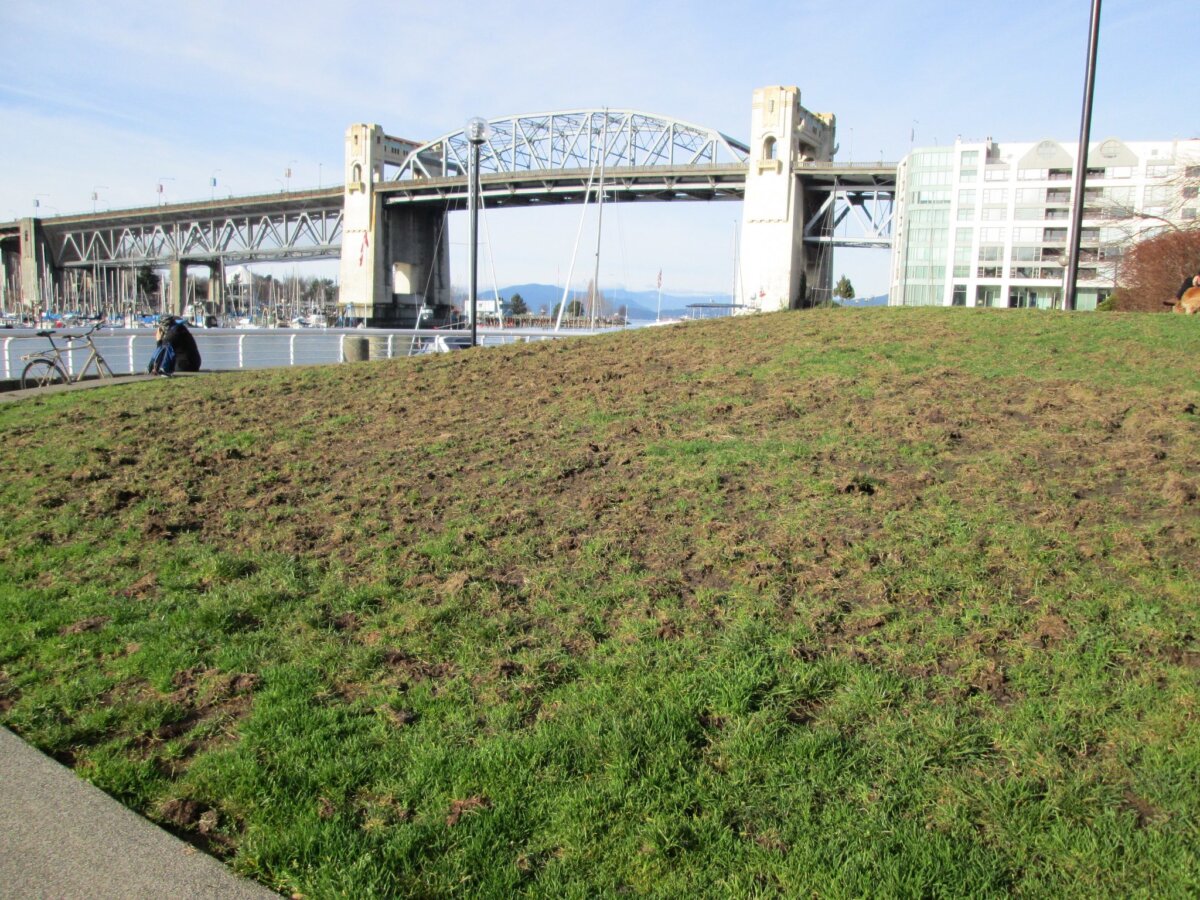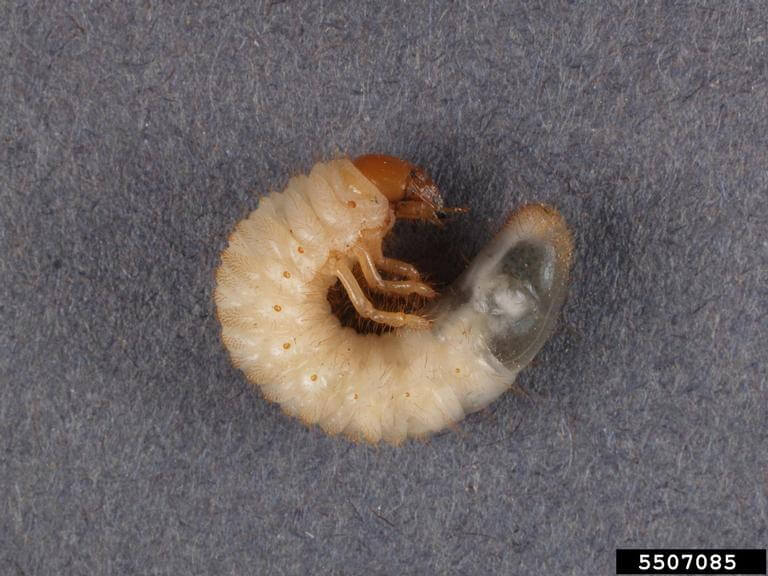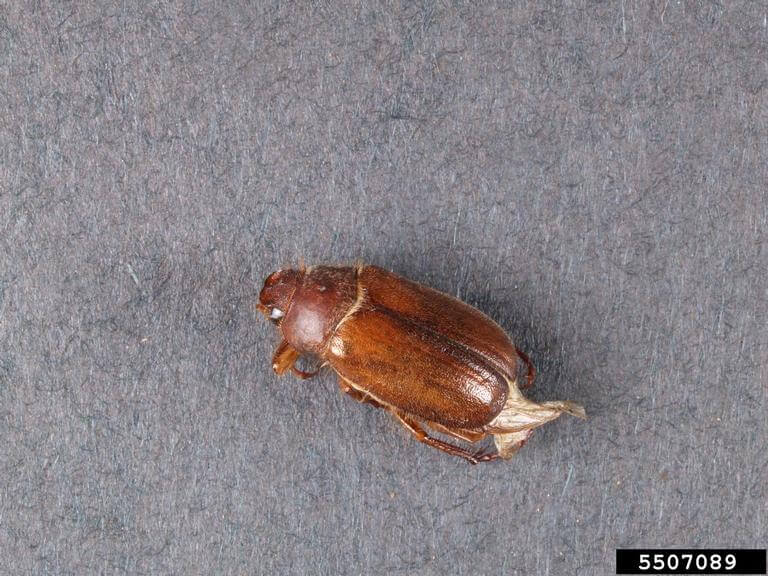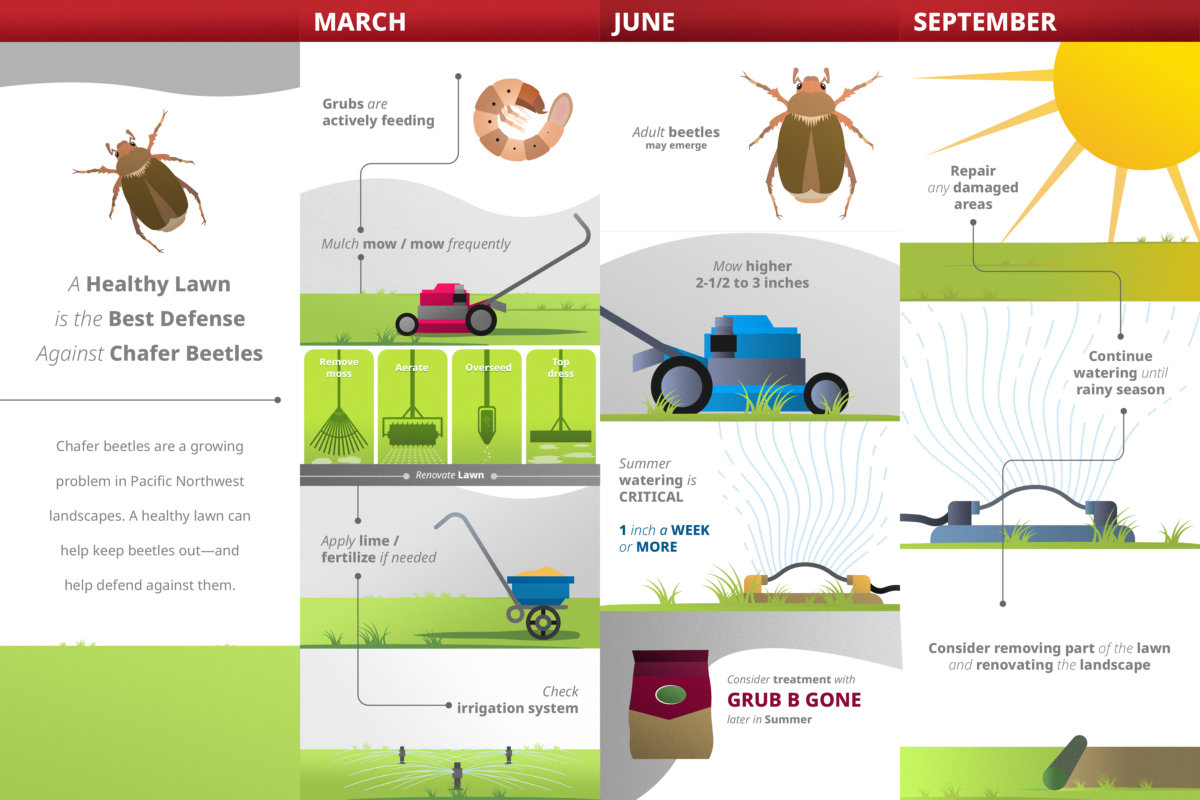
Crows, raccoons and other animals rip up lawns looking for chafer beetle grubs, causing extensive damage. Stephen Rees photo of Vancouver lawn.
Does your lawn look like it has been rototilled? It is likely the result of hungry wildlife feeding on an invasive insect, the European chafer beetle, found in turf. People have reported major damage to their lawns, and local cities have seen destruction of athletic fields.

European chafer beetle grubs (larvae) eat the roots of turf. Wildlife tear apart lawns looking for grubs to eat. Bruce Watt, University of Maine, Bugwood.org.

European chafer beetle adults emerge, fly into trees to mate, and lay eggs in June. Bruce Watt, University of Maine, Bugwood.org.
The European chafer beetle is a serious pest of turf, horticulture, and field crops. It was reported just across the border in the Vancouver, BC, area in 2001, and has been in the Seattle area since 2015.
The most severe damage is not caused by the beetle or its grubs (larvae) but by wildlife that are trying to feed on the larvae that live in the soil under the grass.
As reported by Let’s Talk Mercer Island, “Raccoons will dig and roll away a section of turf for the meal that lives just two inches under the soil. Crows, on the other hand, will pick, pluck, and pull the larvae out of the grass, taking clumps of grass with it.”
Adult beetles are active in June
In June the adult beetles emerge and swarm into trees or shrubs to mate. This often happens at night, so you may not see much evidence of the beetles. After they mate, female beetles tunnel down beneath the grass and lay up to 50 eggs.
The eggs hatch about two weeks later, and grubs start feeding. Beetle grubs live underground through fall and winter, feeding on grass roots and damaging turf.
What to do now: water your lawn
According to Michigan State University, “Frequent irrigation during the last two weeks of June makes the turf much less attractive to the adult females for egg laying. Irrigation during the fall helps turf survive root pruning by grubs.” The timing may be slightly different here, depending on when the adult beetles emerge and mate.
What else to do: keep your lawn healthy
Chafer beetles appear to be more of a problem on lawns that are dry, thin and unhealthy. If you keep your lawn healthy, it should help prevent chafer beetles from invading and help restore any damage if they do invade. Proper mowing and watering are important to keep your lawn healthy.
Mow higher
Raise your mower height to 2-1/2 to 3 inches. Higher grass shades the soil, reducing evaporation. And mulch mowing is a good idea. It feeds the lawn, reducing fertilizer needs. Read our blog post on mowing tips for a healthy lawn.
Continue watering during summer
Summer watering is critical to manage chafer beetles. According to Michigan State University, “Irrigated lawns have shown resistance to damage in the Midwest and on the East Coast.”
Your lawn needs one inch or more each week. Water deeply to encourage deep rooting and reduce drought stress. It is best to water once or twice a week rather than daily. Watering frequency depends on whether you have clay or sandy soil. Read our blog post on lawn watering.
Consider treatment with Grub B Gon later in summer
Grub B Gon is a biological control product (BTG, or Bacillus thuringiensis galleriae). It is safe for people and pets. The active ingredient – a live, soil-borne organism – is released down into the soil and root zone where grubs live. As grubs eat plant roots, they also ingest the active ingredient, effectively putting a stop to them and their destruction.
Grub B Gon can be an effective product if used correctly. According to Arts Nursery Garden & Home, summer is a good time to use it because the grubs are most active then. It is applied with a fertilizer spreader, and the lawn must be watered deeply after application so it penetrates the root zone. Don’t mow the lawn until it is thoroughly washed in.
We don’t recommend applying chemicals to treat chafer beetles. Even if the chemicals are “naturally” derived, they can kill worms and beneficial insects.
Manage chafer beetles in March, June, September
Managing chafer beetles can be tough. This pest is a big deal for Northwest lawns. Here is an infographic that summarizes how to manage chafer beetles at different times of the year.

More info
For more details, check out our blog posts on chafer beetles.
- Life cycle of the chafer beetle
- How to manage chafer beetles: what to do in March
- Managing chafer beetles: what to do in September
We can help
We can help keep your lawn healthy so you can prevent chafer beetles from invading and help restore damage. Here is more information about our natural lawn, tree and shrub care services. We would be happy to answer your questions. Contact us to talk with our staff and sign up for services.
Large photo: Stephen Rees. License: Flickr.
